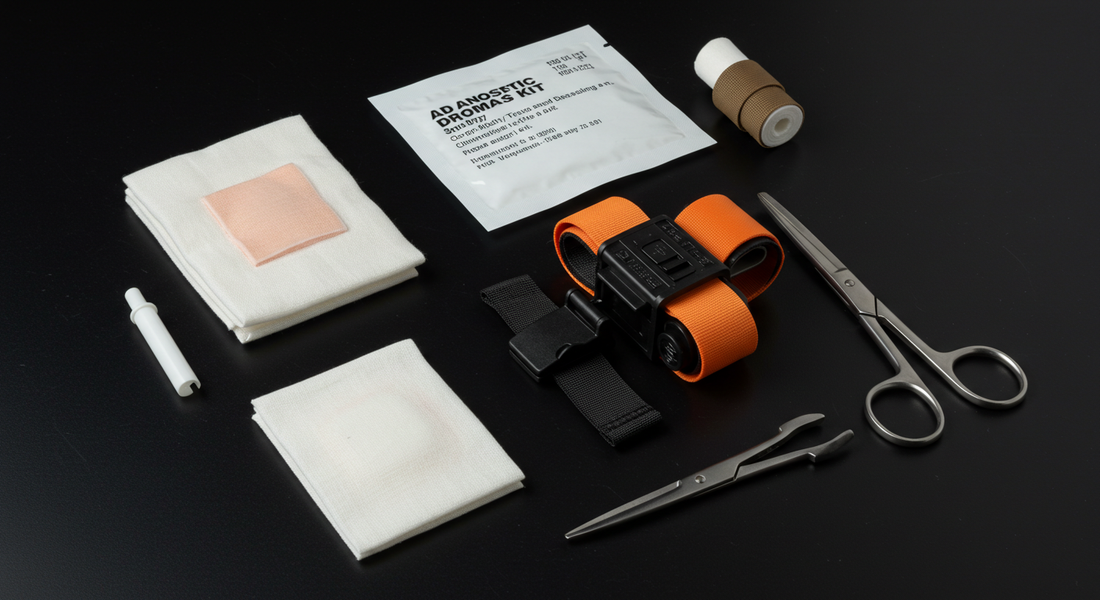
Beyond Band-Aids: How to Build an Advanced Trauma & Bleeding Control Kit
Share

A basic first-aid kit is perfect for the scrapes, cuts, and headaches of everyday life. But in the event of a serious injury from a car accident, natural disaster, or other major event, a box of adhesive bandages and antiseptic wipes is simply not enough. An advanced trauma and bleeding control kit is designed to address life-threatening injuries in the critical minutes before professional help can arrive.
The approach to this level of care is guided by the military-proven MARCH algorithm, which prioritizes the most immediate threats to life: Massive hemorrhage, Airway, Respirations, Circulation, and Hypothermia.
Component 1: Bleeding Control
Uncontrolled bleeding is the most preventable cause of death in trauma situations. Your kit must be built around stopping it, fast.
-
Tourniquets: A modern, commercial tourniquet (like a C-A-T or SOF-T) is the single most important item in your kit. Learn how to use a tourniquet and, just as importantly, how to "stage" it for rapid, one-handed use by pre-routing the strap. A tourniquet is used to stop massive, life-threatening bleeding from a limb.
-
Pressure Dressings: For bleeding that is severe but not arterial, an Emergency Trauma Dressing (ETD), also known as an "Israeli bandage," is essential. It's an all-in-one device that combines a sterile pad with a pressure bar and a wrapping leader to apply focused pressure directly to a wound.
-
Hemostatic Gauze: This is a special gauze impregnated with an agent (like kaolin) that helps to rapidly clot blood. It is used for deep wounds in areas where a tourniquet cannot be applied (like the groin or shoulder, known as junctional areas). It is used by packing the wound tightly to make contact with the source of the bleed.
Component 2: Airway Management
Once massive bleeding is controlled, ensuring the person can breathe is the next priority.
-
Nasopharyngeal Airways (NPAs): An NPA is a simple tube inserted into the nostril of an unconscious person to ensure their airway remains open. It is a basic but life-saving tool. You must be trained on how to properly measure and insert one.
-
Chest Seals: A penetrating injury to the chest (like a puncture wound) can cause a collapsed lung. A chest seal is a special occlusive dressing with a valve that is placed over the wound. It allows air to escape from the chest cavity but prevents air from getting in, which can be life-saving.
Component 3: Other Essentials
A few other simple tools are crucial for a complete trauma kit checklist.
-
Trauma Shears: These are powerful scissors designed to cut through clothing, leather, and seatbelts quickly to expose an injury.
-
Nitrile Gloves: Always have multiple pairs. They protect you from bloodborne pathogens.
-
Emergency Blanket: A mylar "space blanket" is used to prevent hypothermia, which is a serious risk for anyone who has lost a significant amount of blood.
Training: The Most Important Component
This cannot be stressed enough: owning this gear without hands-on training is a dangerous liability. Reading about how to use a tourniquet is not the same as applying one under stress. Seek out professional, hands-on training. A "Stop the Bleed" course is a fantastic, often free, starting point that will give you the confidence and muscle memory to act effectively.
Conclusion: The Confidence to Act
The main difference between a standard first-aid kit and an Individual First Aid Kit (IFAK vs trauma kit) is the focus on immediate life threats. Assembling your kit is the first step. Store it in a clearly marked, easily accessible location in your home or vehicle. But the true value comes from combining the right gear with the right
